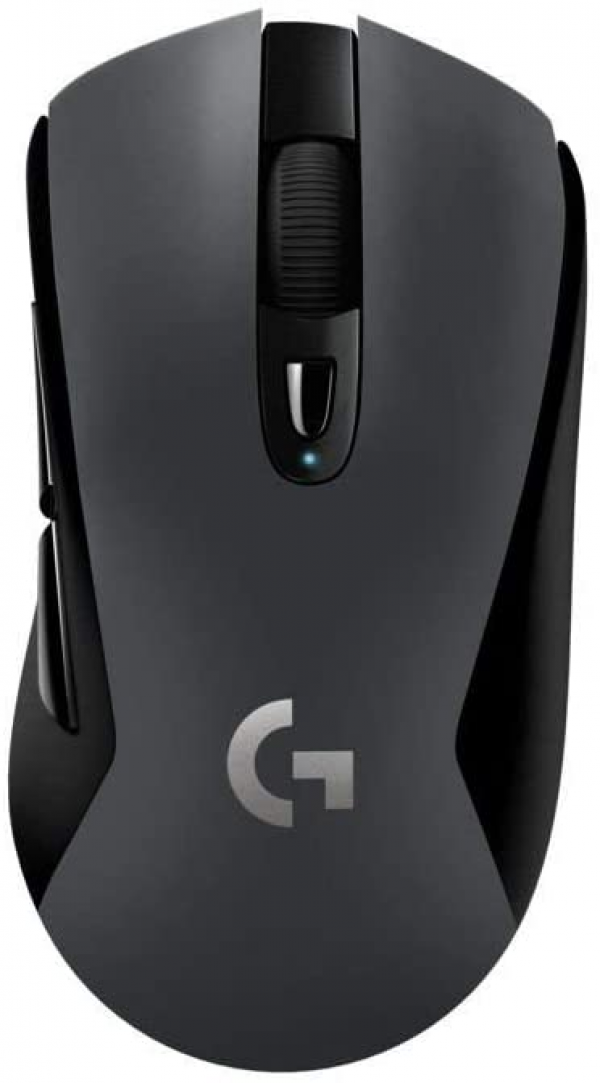Logitech
Logitech G603 Lightspeed mouse: a Hero sensor to save autonomy
Aprox. 56€
See specificationsPresented at the same time as the manufacturer's G613 keyboard - with which it actually goes very well, in technology as in design -, the Logitech G603 Lightspeed mouse can be compared to a battery version of the G403 Prodigy Wireless and G703. If it loses the backlight of the latter, it instead introduces the Hero sensor from Logitech, designed mainly for performance and energy efficiency.
Positive points
Comfortable grip.
Good build quality.
Large, well-placed and responsive buttons.
Excellent sensor: precision and reactivity.
Great autonomy.
Works with one battery as with two.
Soft and well serrated wheel.
Bad points
Non-disengageable thumbwheel and no horizontal scrolling.
Only 3 additional buttons.
Works only wirelessly.
Smooth edges, without non-slip coating.
For right-handers only.
Slightly heavier than its battery powered binoculars.
Our review
Presentation
Little sister of the G403 Prodigy Wireless and G703, the G603 is therefore distinguished mainly by its battery power rather than by battery. As a direct consequence, its price is significantly lower: € 79.99 against € 119. Let's see what are the consequences of this choice and the other differences that could justify the release of this new, less expensive model.
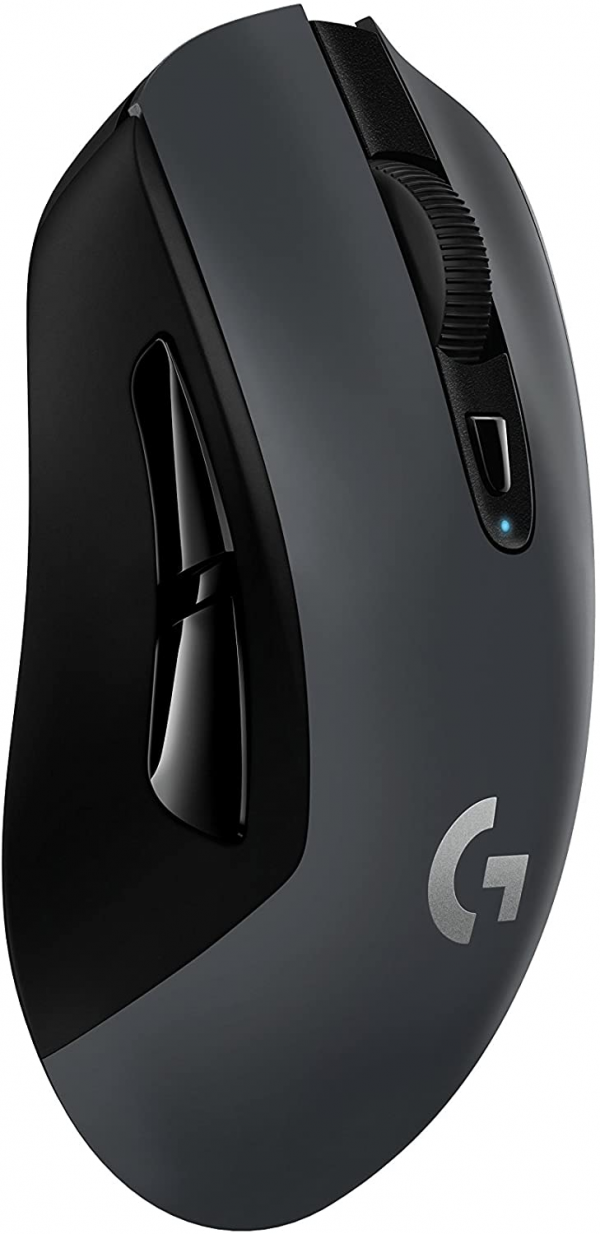
Ergonomics
At first glance, the G603 looks furiously like its older G403 Prodigy Wireless and G703. Same shape and same dimensions to the nearest millimeter (128 x 68 x 43 mm), only the color distinguishes it, since the newcomer has a gray dress rather than black, which goes perfectly with the G613 keyboard. We can also note in passing that no backlighting is provided, the G logo here being simply silver. We will not complain, this effect being more aesthetic than anything else on the vast majority of mice on the market. The finish is still as neat, with no visible screws and with precise adjustments (little play between the pieces). On the other hand, despite the use of soft plastics (soft-touch type), we cannot say that the G603 gives the impression of a high-end mouse; we made the same observation with the G403. At least it fits more easily into a work environment.
Nothing new in terms of design therefore: we are dealing with a mouse with relatively sober lines and nevertheless quite current. Always also domed, the mouse fits very well in the palm of the hand, inviting readily to put the palm there. Large hands will particularly appreciate being able to handle it without too much fatigue, while retaining the possibility of grasping it more firmly (claw grip) during video game games. However, we would have appreciated non-slip materials on the edges, for better hold, the fingers tending to slip easily (the G403 and G703 benefit from this however).
This absence is especially noticeable when it comes to lifting the mouse to refocus it, especially since the choice of a battery supply induces a higher mass. Indeed, while the G403 Prodigy Wireless and G703 weigh only 107 g, the G603 cannot go below 112.3 g with an AA battery (135.7 g with 2 batteries).
This is very reasonable for a wireless mouse, especially since it can be satisfied with a single battery, but it is difficult to understand why Logitech did not keep non-slip edges even when this G603 is a little more heavy than its elders.
Question slips, the 2 long PTFE pads provide a good fluidity of movement and are also quite quiet, even on hard surfaces. Logitech ensures that they can be used for "more than 250 km". We haven't gone so far as to verify this claim, but the skates indeed seem thick enough to last.
As for the buttons, no madness: the G603 only offers 6. Too bad that Logitech does not offer a little more, as it could have done on other older mice (G402, G502, G602 ...). The fingers fall perfectly on the two main buttons, slightly concave for better centering. The mouse is also tilted slightly to the right, favoring a more natural position of the hand.
The clicks on the main buttons are straightforward, thanks in particular to the spring tensioning mechanism allowing the contactors to be kept as close as possible to the switches. They have nothing more to prove in terms of click quality, Logitech having chosen the widely used Omron D2FC-F-7N in their guaranteed version for a minimum of 20 million activations. Enough to see the years come fairly calmly, in principle. On the other hand, without being able to really describe them as noisy, they are not the most discreet.
The two buttons on the left edge are very large and easily accessible, it's a pleasure to use them. Unfortunately, the same cannot be said of the button to change the sensitivity of the sensor on the fly (default function, modifiable in the mouse software) located above the wheel, which requires some digital gymnastics to be reached without moving the whole hand.
No problem however on the level of the wheel, pleasant to handle because both fluid and silent. Unfortunately, you have to do without fast scrolling and horizontal scrolling. Its notches could also have been a little more marked - but they are no less so than on the G403 and G703.
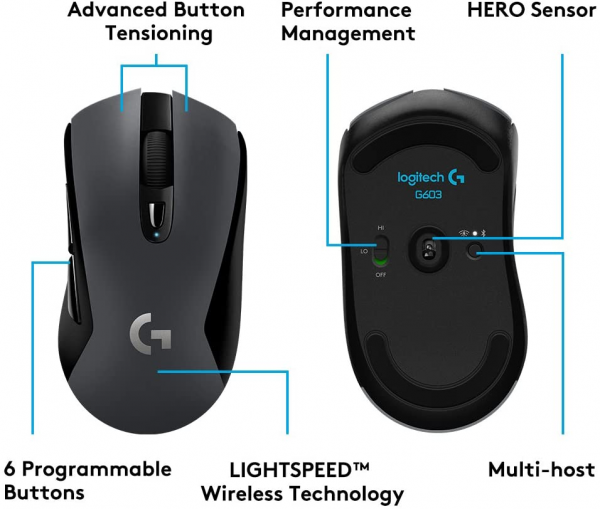
Precision
No more PMW3366 from Pixart, it's time for a new optical sensor developed in-house and called Hero (for "High Efficiency Rated Optical"). Advertised as 10 times more efficient than the PMW3366, it therefore has its place in a wireless mouse where energy saving is essential. Logitech thus announces 500 hours of "uninterrupted play" in "HI" mode, synonymous with an exchange frequency of 1000 Hz (1 ms) between the mouse and the computer. In office use, the "LO" mode proves to be sufficient, the mouse then operating at 125 Hz (8 ms) for an autonomy which would climb this time to 18 months (in "normal use", therefore not uninterrupted).
This energy efficiency is not at the expense of performance and precision, the Hero sensor also behaving like the PMW3366 which equips many Logitech G mice. We find the acceleration support up to 40 g, a speed completely crazy maximum of 10.16 m / s and a very largely sufficient sensitivity of 12,000 dpi (adjustable from 200 dpi in steps of 50 dpi). Remember in passing that at this maximum sensitivity, a movement of less than a centimeter is enough to cover the entire width of an Ultra HD screen; we can then say goodbye to precision. This is why more and more manufacturers - including Logitech - no longer put forward this technical characteristic, which today does not mean much anymore. The fact remains that this Hero sensor seems well designed. Impossible to get him off the hook, the G603 responds to the most violent stresses.
The wireless link here is not at all a handicap and has nothing to envy to a wired link, since Logitech uses its Lightspeed technology, ensuring very low latency. We had already tested it during the G900 test and still did not perceive any latency during our tests. However, this is only valid over the air, with the small USB transceiver provided. The mouse can indeed work in Bluetooth, which is especially recommended for use on a laptop, for example. The latency in Bluetooth is indeed always higher.
Surface recognition is also of a very good level, since even slightly satiny, even slightly shiny, coatings seem to be suitable for this sensor. Of course, glass or any other surface that is too reflective or transparent is a problem for him, but only a good laser sensor can accommodate these specific surfaces. However, we always recommend a good mouse pad, especially in video games, in order to take advantage of the best possible accuracy, smooth movements and reduce the wear of the pads.
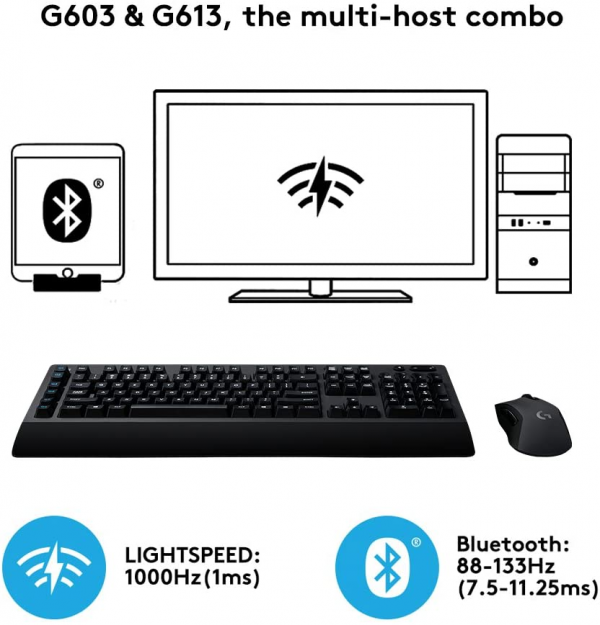
Conclusion
Comfortable for both gaming and office use, the G603 offers excellent performance thanks to its Hero optical sensor. The latter also ensures a high autonomy, which is not so common in the middle of mouse for players, especially since it remains quite light for a battery model.
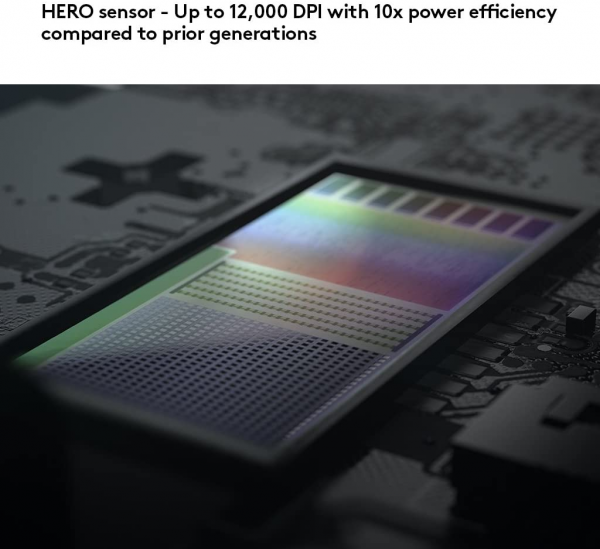
Specifications

